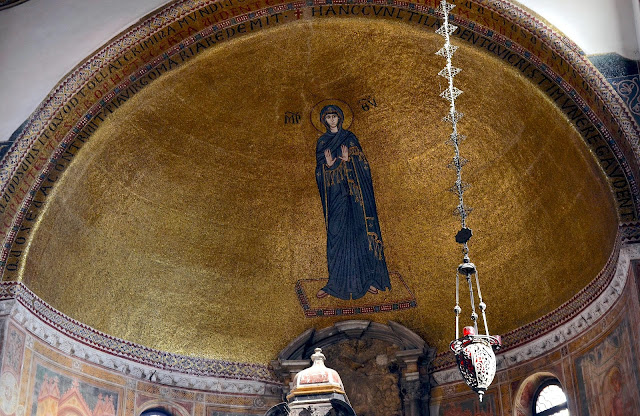There has always been something I've found particularly striking about simple but beautiful apsidal mosaics. Italy has a few such examples (most notably that of the basilica of Torcello, Santa Maria Assunta) and another one that recently came to my attention is that of Santa Maria e San Donato located on the island of Murano, Italy, which is located just adjacent to Venice proper -- so if you're taking a trip to Venice, you may want to add this to your itinerary.
First a quick word about the basilica itself. The original church on this location was constructed in the seventh century with the present structure dating from rebuilding efforts dating to the eleventh century. The basilica is traditionally 'oriented' -- meaning the altar and apse are located toward the East. The ornamental twelfth century Byzantine pavement is what the church is most famously revered for. It contains elements of opus sectile and opus tessellatum work set into geometric designs that include both geometric and figurative depictions -- the latter ranging from the likes of peacocks to other figurative depictions.
The floors are most definitely of interest, but it was the late twelfth century apsidal mosaic of the Mother of God that in particular caught my attention. It was executed by a Venetian master and shows similarities not only to the basilica of Torcello as we have already noted, but also San Marco itself. But while the Madonna of Torcello is a Madonna and Child, the Madonna of Murano stands alone, her arms opened in prayer, she stands upon a suppenadeo and is vested in royal blue attire, wearing the red shoes of Byzantine royalty. this royal blue mantle is set into stark and beautiful contrast with the broad gold field the makes up the rest of the apse.
Our readers are generally interested in seeing the arrangement of these places as they existed prior to the 1970's, so here is an archival photo, probably dated to the nineteenth century.
The floors are most definitely of interest, but it was the late twelfth century apsidal mosaic of the Mother of God that in particular caught my attention. It was executed by a Venetian master and shows similarities not only to the basilica of Torcello as we have already noted, but also San Marco itself. But while the Madonna of Torcello is a Madonna and Child, the Madonna of Murano stands alone, her arms opened in prayer, she stands upon a suppenadeo and is vested in royal blue attire, wearing the red shoes of Byzantine royalty. this royal blue mantle is set into stark and beautiful contrast with the broad gold field the makes up the rest of the apse.
There are various other items of liturgical art of interest to be found here, not least of which the polyptych dated to the second half of the fourteenth century that is presently acting as an antependium for the post-conciliar altar.
Finally, just a quick peak at some of the other objects of interest to be found here.
,_interno,_lampada_alla_bizantina.jpeg) |
| A Byzantine style lampada that hangs in the centre of the nave of the church in a similar arrangement and style as is also found in San Marco in Venice. |
 |
| The medieval pulpit / ambo. A great example of noble simplicity. |
,_interno,_vecchio_battistero,_frammenti_di_transenne_del_ix_secolo_01.jpeg) |
| A fragment of the ninth century transennae |
-------
Do you like Liturgical Arts Journal's original content? You can help support LAJ in its mission and vision to promote beauty in Catholic worship either by:
You choose the amount! Your support makes all the difference.







,_esterno,_05.jpeg)








_(14595753660).jpeg)







